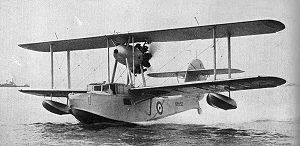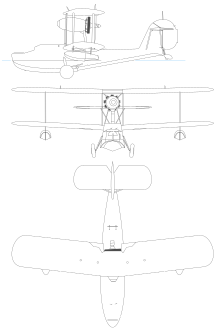Supermarine Walrus
| Supermarine Walrus | |
|---|---|

|
|
| Type: | Flying boat |
| Design country: | |
| Manufacturer: | |
| First flight: |
June 21, 1933 |
| Commissioning: |
1935 |
| Production time: |
1936-1944 |
| Number of pieces: |
740 |
The Supermarine Walrus was a single-engine amphibious catapult - capable double-decker flying boat made by the British manufacturer Supermarine Aviation Works (part of Vickers-Armstrongs from 1928 ). It was designed by Reginald Joseph Mitchell , built in the Woolston suburb of Southampton , and put into service from 1935. The first user was the Royal Australian Air Force (RAAF), which used the machine as the Supermarine Seagull Mk.V for the cruisers of the Royal Australian Navy (RAN) and the seaplane carrier HMAS / later HMS Albatross . In 1939, the Walrus was used as an on-board aircraft on almost all cruisers of the Royal Navy .
Developed as an on-board aircraft for catapult launch for artillery observation and reconnaissance, the machine also took on other tasks and was used particularly successfully for sea rescue in order to rescue crews who had landed in an emergency. It remained in use throughout the Second World War .
history
In 1923 the revision of the Supermarine Seagull began after the first operational experience. Supermarine built a prototype Sheldrake according to the order , but there was no series production. The structure of the Seagull was used in 1928 for two more prototypes, which were named Seamew . They were small twin-engine flying boats that were tested until 1930 but did not convince.
In 1930 the development of a small flying boat began with a metal frame and was powered by a Bristol Jupiter IX engine with a pusher propeller. The new type should be used by the Australian seaplane carrier HMAS Albatross and as an aircraft on board of cruisers , since the Seagull Mk.III used in Australia was not catapult capable. This machine was named Seagull Mk.V , first flew in 1933 and was first used in the Australian Navy from 1935. Further developed and ordered by the Royal Navy / Fleet Air Arm in 1935, it was named Walrus and became the most built British flying boat and even had a double-decker successor with the Sea Otter . In order to accommodate the Walrus as space-saving as possible, the wings could be folded, which gave the aircraft a minimum width of 5.5 m.
The first versions of this aircraft were made in 1935. 740 copies were produced in series from 1936 to 1944.
The Walrus was produced in series in two versions, the Mark I (made of metal) and the Mark II (made of wood) and delivered to the RAF , RNZAF , RAAF , RNZN and the Fleet Air Arm . Mostly it was used as an observation and sea rescue aircraft, but sometimes also for anti -submarine defense. In total, at least four German submarines and a French one were sunk by Walrus during the Second World War .
The last Supermarine Walrus was decommissioned in 1947.
Production numbers
The Walrus was built in series at Saunders Roe (453 copies) and Supermarine (283 copies). There were a total of 736 walrus.
| year | number |
|---|---|
| until 1938 | 187 |
| 1939 | 54 |
| 1940 | 57 |
| 1941 | 132 |
| 1942 | 207 |
| 1943 | 96 |
| 1944 | 3 |
| total | 736 |
Military users
-
 Argentina , two Seagull Mk.V with school cruiser La Argentina , eight machines delivered in 1947, in use to explore the Antarctic,
Argentina , two Seagull Mk.V with school cruiser La Argentina , eight machines delivered in 1947, in use to explore the Antarctic, -
 Australia
Australia
-
 Egypt
Egypt
-
 France
France
-
 Ireland , three machines from March 1939, N.18 (initially L2301) now in the Fleet Air Arm Museum in Yeovilton , England.
Ireland , three machines from March 1939, N.18 (initially L2301) now in the Fleet Air Arm Museum in Yeovilton , England. -
 Canada
Canada
-
 New Zealand
New Zealand
-
 Soviet Union
Soviet Union
- Soviet naval forces , one machine in Arkhangelsk from 1942 to 1943 .
-
 Turkey
Turkey
-
 United Kingdom
United Kingdom
Civil users
-
 Australia
Australia
- Amphibious Airways in Rabaul with four ex-RAAF planes; Approval for use with up to ten passengers; used in charter operations and as an ambulance; used until 1954.
- VH-ALB ex RAAF A2-4 , used for tourists until 1962
-
 Canada
Canada
- Kenting Aviation
-
 Netherlands
Netherlands
- Willem Barendsz (I); bought two machines for use by the whaling mother ship ; not used
-
 Norway
Norway
- Vestlandske Luftfartsskelskap in Bergen , two machines used as air taxis and cargo machines
-
 United Kingdom
United Kingdom
- United Whalers bought six machines, three used in the 1946/1947 fishing season in Antarctica from the factory ship Balaena , which had an ex-Royal Navy catapult and lifting crane.
Technical specifications
| Parameter | Data |
|---|---|
| constructor | Reginald Joseph Mitchell |
| crew | 3-4 |
| length | 11.46 m |
| span | 13.96 m |
| height | 4.87 m |
| Wing area | 56.67 m² |
| payload | 1040 kg |
| Empty mass | 2220 kg |
| Takeoff mass | 3250 kg |
| Cruising speed | 152 km / h |
| Top speed | 216 km / h |
| Service ceiling | 5640 m |
| Range | 960 km |
| Engine | a radial engine Bristol Pegasus -VI, 775 HP (570 kW) |
| Armament | three 7.7 mm Vickers machine guns , 272 kg bombs |
See also
literature
- David Brown: Supermarine Walrus I & Seagull V Variants . Aircraft in Profile, Volume 11 , Profile Publications Ltd., Windsor 1972.
- William Green: War Planes of the Second World War, Volume Five: Flying Boats , Macdonald & Co. (Publishers) Ltd., London 1962 (5th edition 1972). ISBN 0-356-01449-5 .
- James Kightly / Roger Wallsgrove: Supermarine Walrus & Stranraer , Mushroom Model Publications, Sandomierz, Poland / Redbourn 2004. ISBN 83-917178-9-5 .
- Peter London: British Flying Boats , Sutton Publishers Ltd., Stoud 2003, ISBN 0-7509-2695-3 .
- Owen Thetford: British Naval Aircraft since 1912 , Putnam, London 1982 (5th edition), ISBN 0-370-30021-1
Web links
- A description and pictures of the Walrus (English)
- A description of the Walrus in the Fleet Air Arm Archive (English)

